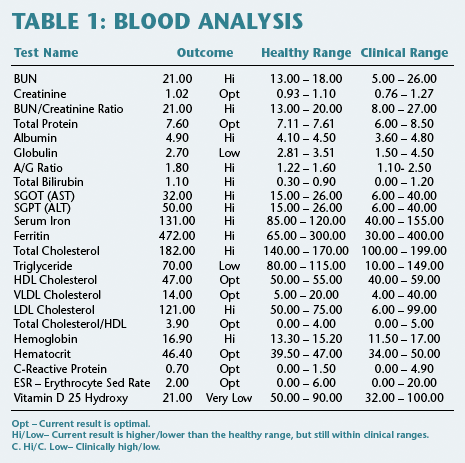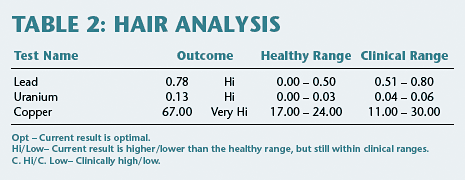Walk into your chiropractic office any day of the week and I could almost guarantee you this guy would be one of your patients: 50s or 60s, high cholesterol, high blood pressure – probably on medications for both; mild fatigue and overweight, with most of the excess around his midsection (which sticks even though he claims to "exercise"). Does this guy sound familiar? He should.
This means roughly 30 million individuals in the U.S. have tried and failed to control their blood pressure, and another 16 million are completely unaware they suffer from what the medical profession refers to as "the silent killer." Hypertension killed 56,561 people in the United States in 20063 and by looking at the cholesterol stats, you can see that high cholesterol is affecting the population at similar rates. These patients are sitting in your office, they are on tomorrow's schedule and you are in a prime spot to help them achieve better health in ways no one else can.
I had a patient matching the description above not too long ago who was urged by his wife to come see me for a nutritional analysis. He was 64 years old, on medications for high blood pressure and high cholesterol, 5'6", 175 lbs, walked 1-2 miles a few times a week for exercise, suffered from mild fatigue, etc. The day of his first visit, his BP was 120/76; looking over previous testing supplied by his medical doctor from April and November of 2009, I could see that the results of his total cholesterol had recently climbed from 165 to 186 and his LDL (bad) cholesterol had jumped from 106 to 126. His goal was to control his blood pressure and cholesterol without using prescription drugs.
We know that all kinds of things affect your blood pressure – stress, being overweight or obese, history of smoking, kidney dysfunction, excess salt intake, alcohol consumption, adrenal disorders, thyroid disorders, lack of exercise, etc.; and the list for cholesterol problems is just as long. Despite all this knowledge, the American Heart Association claims that the cause of 90-95 percent of high blood pressure cases is unknown.5
If this were your patient asking for help, what would you do? Suggest vitamins, a special low-sodium or gluten-free diet, garlic or red rice yeast, adrenal support, adaptogens (herbs believed to increase the body's resistance to stress, trauma, anxiety and fatigue), hormone therapy, digestive aids? Ask yourself this first:
- What are the real problems?
- What are symptoms of the real problems?
The symptoms are high blood pressure, cholesterol and fatigue, but the only way to determine the "real problem" is through comprehensive testing; looking at toxins and essential elements in the hair and a broad-spectrum blood panel encompassing glucose, hemoglobin A1C, kidney function, liver function, a complete metabolic profile, iron levels, cholesterol, thyroid, complete blood count, inflammation markers, and vitamin D levels. If we know what sort of things cause high blood pressure, why not work harder to track down and treat the cause, rather than supplying patients with a quick-fix drug that for 30 million individuals, is simply not enough?
Table 1 shows a few of the few highlights from the patient's test results: (Note: I use what I call a healthy range when analyzing blood test results. This is a stricter range than the clinical range used by the medical community and represents guidelines for optimal health.)

The most significant findings from his blood test are the high ferritin and very low vitamin D. Ferritin is a storage vessel for excess iron in the body and each molecule is capable of storing 4,500 atoms of iron. In most cases, only about 20-25 percent of the iron we eat is stored; the rest is excreted in the stool. However, in patients with hemochromatosis, as much as 80-100 percent of the iron the patient consumes is absorbed by the body and forced into additional ferritin storage molecules.6
Iron then collects in the liver, heart, joints, pancreas and pituitary, causing these organs to function poorly or not work at all. Excess iron in the body has been linked to atherosclerosis (hardening of the arteries) and other cardiovascular diseases, poor digestion, cancer, type 2 diabetes, osteoporosis, muscle wasting and liver dysfunction.7 In this instance, some of the liver dysfunction we see with the elevated AST and ALT could also be caused by the medications taken for high blood pressure and cholesterol.
In nearly every case I've seen, high ferritin, high hematocrit (blood volume occupied by red blood cells), high hemoglobin (iron-containing oxygen-transport proteins in red blood cells) with a low or normal c-reactive protein and erythrocyte sedimentation rate (inflammatory markers) is almost always hemochromatosis.
According to the Mayo Clinic, low vitamin D levels have been linked to osteoporosis, hypertension, cancer and several autoimmune diseases. It has also been found that individuals with darker skin pigmentation, populations that live farther from the equator, and the entire population during winter months are at greater risk for elevated blood pressure due to a lower production of vitamin D via sunlight.8
Toxic metals also contribute to many health problems including blood pressure. Copper, which is found in peanuts, shellfish, mushrooms, liver, citrus fruits, diary, cigarettes, herbicides and pesticides, has specifically been linked to high blood pressure, insomnia, heart disease, cancer, liver dysfunction, diabetes, arthritis, depression, memory loss and chronic fatigue syndrome.9 Copper is also added to animal feed to increase growth and weight gain rates, and may have similar effects in humans.10

With the above test findings (Table 2), do you think supplementing with adrenal glandulars, adaptogens, amino acids, fatty acids, digestive enzymes and probiotics, and following a gluten-free and yeast-free diet, etc. will help this patient? No. How many of your patients are on these nutrients or special diets for months or years without significant improvement and get frustrated with the lack of progress and give up?
Adrenal problems will not cause the high ferritin and very low vitamin D. Adaptogens or hormone therapy will not help eliminate the very high copper. However, hemochromatosis, very low vitamin D and high copper can cause adrenal fatigue, low/imbalanced amino and fatty acids, digestive problems, high blood pressure, etc.
When the correct testing is done, the proper course of treatment is usually easy, simple and very effective. I recommended this patient donate a pint of blood every two months for six months for the hemochromatosis (forcing the body to make Iron out of the ferritin stores to replenish red blood cells removed during the donation), take vitamin D3, drink filtered/purified water and eliminate certain foods to reduce copper exposure.
Those suggestions will take care of about 80 percent or more of this patient's problem. He does need a few other vitamins, but basically the solution is quick, easy and inexpensive for the patient. A few months later ,this patient felt better and saw 22 of his blood test results improve including the vitamin D at 62.20, total cholesterol at 164, LDL cholesterol at 98 and ferritin at 305 (compare these numbers to the originals in Table 1). Patients understand the necessity, validity and objectivity of bloodwork and when proper testing is done, the improvements are easy to see.
References
- High Blood Pressure Statistics. American Heart Association. www.americanheart.org/presenter.jhtml?identifier=4621
- Ibid.
- Ibid.
- Cholesterol Statistics. American Heart Association. www.americanheart.org/presenter.jhtml?identifier=4506
- High Blood Pressure, Op cit.
- Diagnostic Aids to Qualify and Quantify Iron. Iron Disorders Institute. www.irondisorders.org/diagnostic-aids
- Chronic Diseases Affected by Iron. Iron Disorders Institute. www.irondisorders.org/chronic-diseases-affected-by-iron
- Vitamin D. Mayo Clinic; Health Information. www.mayoclinic.com/health/vitamin-d/NS_patient-vitamind/DSECTION=evidence
- Pfieffer C, Mailloux R. Excess copper as a factor in human diseases. J of Ortho Med, 1987;2(3):171-179.
- Lavie R. "Iron and Copper Overload." Consumer Health, June 1998;21(6).
Dr. Van D. Merkle, president of Science Based Nutrition, is a diplomate of the American Clinical Board of Nutrition and the American Board of Chiropractic Internists. He is also a diplomate of the recently formed Chiropractic Board of Clinical Nutrition and currently serves as vice president. Dr. Merkle has practiced in the Dayton, Ohio area for more than 25 years, and hosted the call-in radio talk show "Back To Health, Your Guide to Better Living" since 1995.




